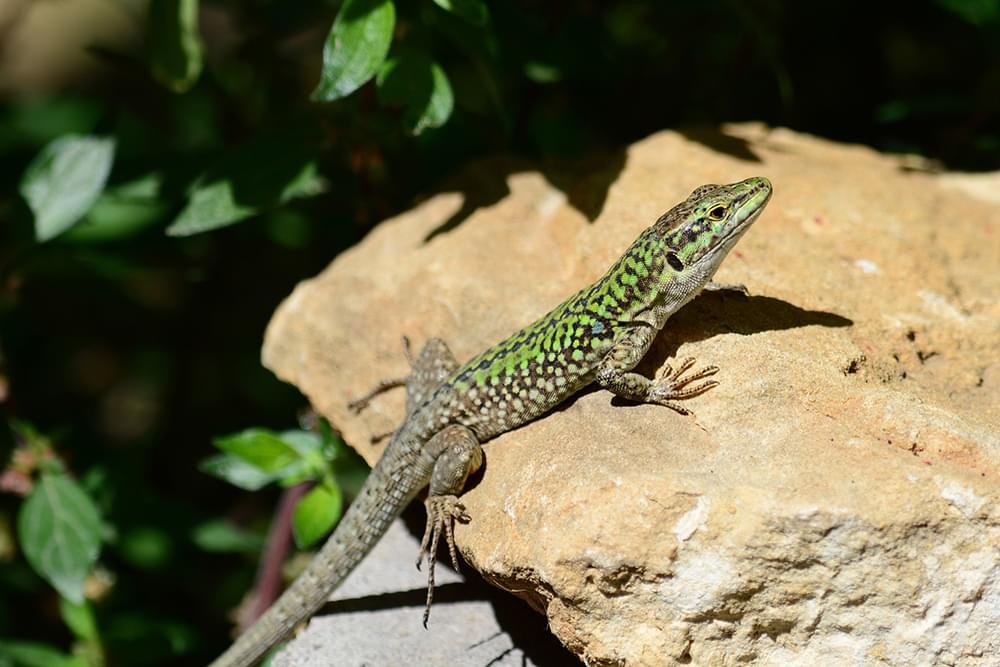
The Italian Wall Lizard, Podarcis siculus, is a remarkable example of adaptability and evolution among reptiles, thriving in various environments across Europe and beyond. Originally endemic to Italy and the Mediterranean islands, this species has expanded its range to parts of North America and other European countries, showcasing its adaptability and ecological impact. This article delves deep into the life of the Italian Wall Lizard, exploring its behavior, habitat, diet, reproductive strategies, and its interactions with the ecosystem.
Podarcis siculus, commonly known as the Italian Wall Lizard, belongs to the family Lacertidae, which encompasses many of the lizard species found throughout Europe and Africa. This lizard is characterized by its robust body, long tail, and sharp, keeled scales which vary in color from green and brown to grey, often with a speckled or lineated pattern that helps it camouflage seamlessly into its surroundings.
Adults typically measure between 15 to 20 centimeters in length, with males generally larger and more vividly colored than females. The males display a brighter color palette during the breeding season, with hues of blue and green on their throats and bellies to attract females. These visual signals, along with physical displays, play a crucial role in their mating rituals.
Initially native to Italy, the Italian Wall Lizard has been introduced to various other regions, including parts of France, Spain, Slovenia, the United States, and Turkey. It predominantly inhabits human-modified landscapes such as urban gardens, stone walls, and ruins, which provide ample basking spots and crevices for shelter. Its ability to thrive in diverse habitats is largely due to its flexible diet and behavioral adaptability.
The lizard's natural habitat ranges from sea level up to 2000 meters in altitude, favoring sunny, rocky areas with abundant vegetation. This environment not only offers optimal thermal regulation opportunities but also a variety of food sources which are crucial for its survival.
The diet of the Italian Wall Lizard is primarily insectivorous, feeding on a wide array of insects and arthropods. However, its diet can be unusually diverse for a reptile, including fruits and seeds, which constitutes a significant part of its intake especially on islands where insect prey may be less available. This omnivorous diet helps the lizard to exploit different ecological niches and survive in areas with fluctuating food resources.
Foraging tactics are particularly fascinating; these lizards are known to be opportunistic feeders, quickly adapting their diet based on availability and season. They use both visual and chemical cues to locate food, and their agile movements and keen eyesight make them proficient hunters, capable of catching quick-moving or camouflaged prey.
Breeding season for the Italian Wall Lizard typically spans from April to June, during which males fiercely compete for territories and mating rights. Females lay multiple clutches of eggs from May through July, with each clutch containing up to 8 eggs. These eggs are deposited in warm, moist soil or under rocks, and take about two months to incubate.
Juveniles are independent from birth and grow rapidly, feeding on smaller prey items and employing more cautious foraging strategies to avoid predation. The lifespan of these lizards in the wild is around 5 to 8 years, although individuals in captivity may live longer with proper care.
The Italian Wall Lizard plays a significant role in its ecosystem, acting as both predator and prey. It helps control insect populations, including those that could be pests to humans. Furthermore, it is a source of food for birds, mammals, and larger reptiles, integrating itself into the local food web wherever it is found.
Adaptation-wise, the Italian Wall Lizard is particularly notable for its rapid evolutionary changes in response to environmental pressures. Studies have documented significant morphological and behavioral adaptations over remarkably short evolutionary times, particularly in introduced populations. These changes include alterations in body size, limb length, and diet, which have allowed it to survive in diverse and often challenging new environments.
Currently, the Italian Wall Lizard is not considered at risk; it is listed as Least Concern by the IUCN. Its wide distribution and high adaptability make it one of the more resilient reptile species. However, local populations can be sensitive to extreme environmental changes
, habitat destruction, and pollution, which could potentially threaten their numbers.
Understanding the dynamics of this species not only helps in conserving it but also sheds light on the ecological impacts of invasive species and the adaptability of life forms facing rapid environmental changes
.The Italian Wall Lizard is a testament to the resilience and adaptability of nature. Its successful spread across Europe and other continents highlights its ability to overcome environmental challenges and thrive in new territories. By studying Podarcis siculus, scientists gain insights into evolutionary processes, species interaction dynamics, and the ecological impacts of human activities. As such, the Italian Wall Lizard remains a subject of great interest within the scientific community and a popular subject of study for herpetologists and ecologists worldwide. Its continued observation and study will be crucial in understanding the balance of our ecosystems and the role invasive species play within them.
This reptile not only embodies the complexity of evolutionary biology and ecological adaptation but also serves as a powerful symbol of nature’s enduring persistence.

More Details